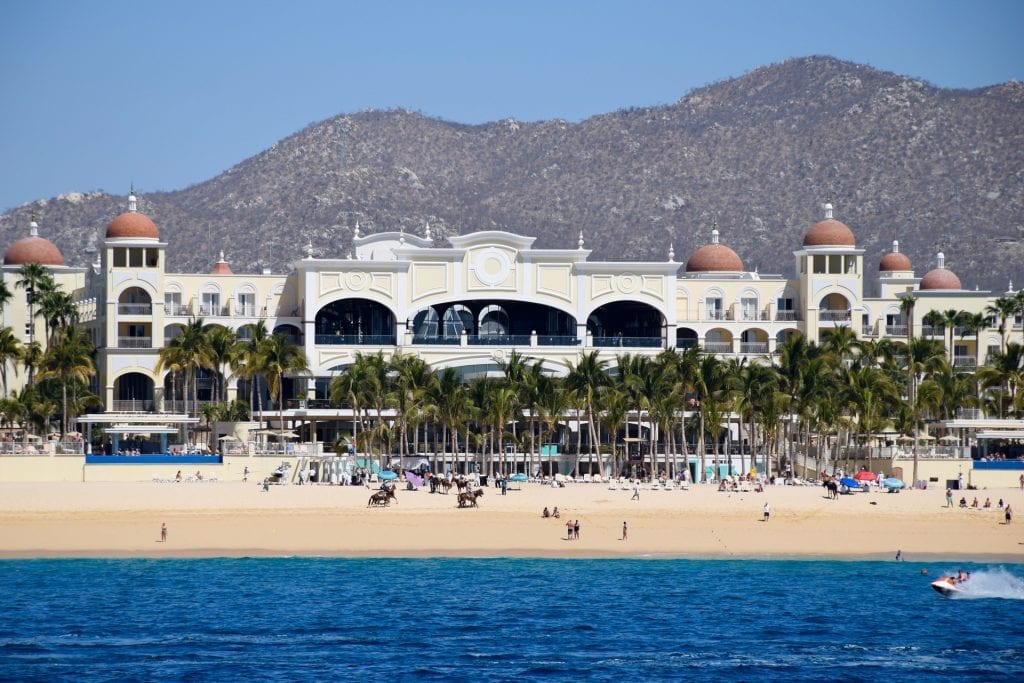Skift Take
Mexico's new government has priorities for tourism, but that doesn't include a tourist board. Will other destinations seize the opportunity?
The question has bounced through the travel industry for months now: What is Mexico doing?
News that the new administration of Andrés Manuel López Obrador planned to disband the Mexico Tourism Board, shift promotional duties to embassies, and redirect money to build a train that visits some popular tourist areas has been out since late last year.
“Everybody’s got their eye on it,” said Bill Geist, CEO of DMOproz, a consulting firm in Wisconsin that caters to destination marketing organizations. “It’s one thing to cut a budget, but to eliminate it is just…it’s a head scratcher.”
There have been few details about what will happen moving forward, even as international offices shutter and continued security concerns make the need for a cohesive communications strategy more acute.
Tour operators and hoteliers in Mexico are fearing for future business, especially as they see a leveling off or decline in bookings this year, and planning ways to take their own action. Foreign visitors spent an estimated $22.5 billion last year in the country.
In the meantime, other warm-weather destinations and tourism insiders are watching to see if the a rollback in marketing dollars will equal increases elsewhere.
“I think it’s terrible,” said Alex Zozaya, CEO of travel, hospitality, and leisure management company Apple Leisure Group. “One thing is to fix what is not working, but leave alone what is working and improve what is working. Because there are some things with the [board] that are not working, let’s shut it down? That’s a big mistake.”
Mexico’s Strategy
Secretary of Tourism Miguel Torruco Marqués revealed the plan in December, following through on the president’s platform that promised social change.
The money that funded the board— it’s not clear how much — is supposed to be moved to an infrastructure project to build what is known as the Mayan Train.
The government also revealed additional priorities late last month, including spreading tourism around the country by encouraging development off more regional attractions; increasing domestic tourism; drawing more high-income visitors from markets including the United States, India, United Arab Emirates, China, Korea, and Russia; and boosting the number of Mexican-American visitors on heritage trips.
Notably, the government’s statement said, some of those programs will move forward with marketing support from the country’s consulates and embassies. Most of the international tourism board offices were expected to close by the end of February.
Carlos Gerardo Izzo, a spokesman for the Mexican consulate in New York, told Skift last month that the government believes the message can spread more efficiently through the existing network of consulates and embassies.
“That doesn’t mean in any way that we are going to promote less our country,” he said. “We’ll keep our effort to show the world that Mexico is a wonderful place to visit for tourism, for business, or for any purpose.”
What’s not clear is how, or through what programs, and how they will maintain relationships in the travel industry. Another question: what will happen to the assets and training materials provided through the tourism board’s Visit Mexico site.
Alfonso Sumano, who heads up the board’s New York office, didn’t have many answers when he spoke to a group of travel insiders at the end of February.
“To be honest with you, at this point I do not have a total certainty what the plans are going to be executed in the future,” he said in response to an audience question. “The tourism board is going to close as it is now. … They have to solve a couple of very interesting issues. First the funding and then the strategy.”
Sumano said he had been writing nine or 10 different papers with suggestions, and was urging the government to keep its online training resources live. He said he expected to hear a more clear strategy soon, with the private sector playing a bigger role.
He said it’s crucial for someone from the country to stay in touch with travel partners, distribution channels, associations, and travel agent groups; keep lines of communication open; and continue the digital presence of VisitMexico.com, as well as training tools that live on the site.

VistMexico.com will continue to be a marketing tool for Mexico tourism despite the decision to close tourism offices worldwide.
“We understand that there are sometimes other priorities, but we need to keep on going,” Sumano said. “We don’t need $300 million to promote Mexico. We just need a few tools and the resources to do our job and specifically be in communication with all of you.”
Employees of several global offices could not be reached for comment; officials with the board, known in Spanish as the Consejo de Promoción Turística de Mexico, also did not respond to questions.
Potential Fallout
Sumano and others said they expected not to see any direct impact from the decision to eliminate the tourism board immediately. The government said 41.5 million people visited the country last year, up from 39.3 million in 2017.
“If they stop and shut down the promotion or we decide not to do it proactively as we did in the past, it will have an impact in the mid to long term,” Sumano said.
Already, there are signs of pressure.
Zozaya said Apple Leisure is seeing a significant decline in Mexico, where it does about half of its business.
Cancun and the Riviera Maya, he said, have been down 14-16 percent compared to a year before, with about 70 percent of winter business on the books. Every destination in Mexico is down, he said, some in the number of passengers and rate and some just in terms of the quality of visitors.
Jamaica, on the other hand, is up 20 percent, the Dominican Republic is up 12 percent and Costa Rica is up 25 percent compared to the previous year.
“Clearly, Mexico is losing market share,” Zozaya said, citing “a perfect storm” of factors.
Aside from the reduction in money for marketing and promotions, Mexico is still struggling with crime and violence in some areas and the negative perceptions that come with that; seaweed that has been washing on popular beaches; and increasing hotel room supply.
The U.S. State Department issued a recent security alert for travelers heading to Mexico for spring break, making fresh headlines. That’s on top of earlier warnings to “exercise increased caution” in the country and avoid some sections altogether.
“With the travel advisories that are out, they need to get control of that message. And there’s nobody to control that message,” Geist said. “I think that’s the biggest issue. There’s no way to control the brand, no way to control the message. There’s nothing coherent.”
With a reputation as a good value for Americans, at least in some popular spots, Mexico could suffer if other countries make targeted offers to draw budget-conscious travelers.
“Any destination that is a direct competitor to Mexico right now should be saying thank you to the Mexican government if they go through with this,” said Amir Eylon, president of tourism consulting firm Longwoods International. “The Mexican beach destinations obviously compete with other beach destinations in Central America and the Caribbean and even the U.S. Do I go to a Florida beach or do I go to Cancun?”
Geist, of DMOproz, said he expects Caribbean and Central American destinations to benefit, with one poised to gain in particular: “I think Puerto Rico’s the winner,” he said. “The beauty of Puerto Rico is if you’re American, you don’t need a passport.”
The destination has also made changes to its own marketing efforts, launching a new tourism board last year.
“We go where we’re invited,” Geist said.
Discover Puerto Rico Chief Marketing Officer Leah Chandler declined to weigh in on the Mexico decision. But, she said, “We believe international representation with local expertise is very important to the success of tourism promotion abroad.”
Hugh Riley, secretary general of the Caribbean Tourism Organization, shared that sentiment. He said he couldn’t comment directly on Mexico’s decision since he wasn’t clear on the circumstances surrounding it. But he said he is still a big believer in the power and necessity of tourism boards.
“Tourist boards provide a certain authenticity about a destination that people absolutely still want,” he said. “So when we’re talking about people making decisions about traveling to the Caribbean — whether they are making a decision about investing in the tourist sector in the Caribbean, whether they just have questions about entry requirements to some Caribbean country — tourist boards are still authentic and very real sources of that information.”
And, as Eylon predicted, Riley did greet the Mexico decision with some sense of gratitude.
“I mean, if any competitor of the Caribbean wants to shut down its tourist offices, then we welcome that,” Riley said. “If they want to cut their budget off, then we welcome that.”
Geist said he expects to see resorts promote themselves more heavily on their own — though he also thinks that will have a chilling effect on future investment.
“If I’m an investor looking to build a resort and I find out that they don’t have a tourism office, I’m not investing,” he said. “I think their international investment is going to slow to a crawl. I’d never go into a destination that didn’t have a DMO.”
Colorado’s Cautionary Tale
Observers were quick to reference a decades-old case in Colorado as an example of what can happen with the tourism promotion spigot runs dry.
After voters decided in 1993 to end funding for Colorado’s tourism board — a savings of $12 million a year — the state’s market share dropped 30 percent in two years, according to a Longwoods study. That amounted to an annual loss of $1.4 billion in tourism revenue, which grew to $2 billion a year in lost spending.
“The result should have been a cautionary tale to any other destination,” said Cathy Ritter, who became director of the Colorado Tourism Office three years ago.
“The corollary to the story is that it took almost 20 years for the state to recover its market share,” Ritter said. “Because what happens when you stop tourism promotion … is that you not only lose ground, other states leap ahead of you. That was the hole that Colorado had to dig out of for two decades.”
She said small destinations are often hurt the most by such top-level cuts, because they don’t have their own hefty marketing budgets.
“The pain is disproportionate,” Ritter said.
Eylon, the Longwoods president, said the threat remains widespread today.
“We see it at all levels. It’s kind of a roller coaster,” he said. “Funding goes up, funding goes down. Now it seems to be at least in the U.S., you see more attacks at the [convention and visitors board] level.”
Eylon added: “I think total elimination of a marketing program is rare. Cutting back not so rare.”
On-the-Ground Solutions
Local tourism boards in Mexico, which already promoted themselves independently, are staying the course — or figuring out ways to do more.
Rodrigo Esponda, managing director of the Los Cabos Tourism Board, said his public-private organization had already been considering opening an office in Los Angeles.
“It is a plan that hopefully we will start sometime soon,” he said. “What we are discussing as a change and as a process of adaptation, probably it would be the right time to really think about it and review the process and to review if it is the right time to do so.”
Esponda said the board — which gets money from a hotel tax — has its own plan and strategies that it will continue to pursue, though it has teamed up with other destinations and the Mexico Tourism Board in the past and would be willing to do so in the future.
“With or without the Mexico Tourism Board, we have a clear objective and a very clear strategy that we are following in 2019 and that we followed in 2017 and 2018,” he said.
The destination saw 6 percent growth last year on top of 17 percent growth the year before. In January, the number of international visitors by air was up 4 percent, while domestic visitors increased 10 percent.
He said the destination’s position and its relationship with partners, wholesalers, agents, and others, is sound: “We are not a new organization, nor an organization that is trying to improvise in the market.”
Matteo Luthi, chief operating officer and part owner of luxury tour operator Journey Mexico, said his company is strengthening its newsletters, marketing materials, and visits, and hiring more people to represent it. In addition to a business development manager in the UK and a representative in Russia, Journey Mexico is hiring two people in the United States to be closer to clients.
“Every bad situation or every change you have to see the opportunity,” he said. “We’re definitely not waiting and seeing what’s happening, we are figuring out ways to support and even do better and to step into the light.”
Though Luthi said he is more concerned about global political situations such as Brexit and tension between Mexico and the U.S., he expects to see an impact from the tourism board’s disappearance by next year.
For the company, growth of 5 percent this year pales in comparison to 20 percent last year.
“We are not in a crisis, no, but we have to watch closely the numbers,” Luthi said. “We believe we will be in a good situation. We are not really worried too much. We are making sure to reach our goals.”
As for Zozaya, his efforts are many, including lobbying the government to make them aware of the drivers for tourism. As a vice president of CNET — the Consejo Nacional Empreserial Turístico, or National Business Tourism Council — he is also working on an initiative to involve the private sector in some new entity to promote the destination.
“We’re trying to get the private sector together to come up with an initiative that we can align with the federal government and working with the different states’ governments to come up with a strategy that, understanding that the resources will be more limited, that we are able to put them in the best possible place to be more efficient.”
Zozaya said the issue with that idea is funding; private businesses would be willing to pay some, but he said Mexico should grow contributions from other sources such as Airbnb or cruise ships.
Apple Leisure is also a force behind the YesToMexico coalition, dedicated to emphasizing positive news about Mexico through public relations and messaging to travel agents, tour operators, and others.
The independent group formed recently to address what members saw as misleading or exaggerated stories about safety in Mexico.
“The news of the Mexico Tourism Board decision was not something that we necessarily anticipated and wasn’t a part of our mission at the outset,” said YesToMexico President Tom Brussow, who owns a travel agency in the U.S. “I think our strategy remains the same.”
‘This Is Not Catastrophic’
While Brussow said he doesn’t think it was “the right move” to remove the board’s marketing, promotional, and educational messaging for travel agents and consumer marketing campaigns, his own organization wasn’t dependent on that activity.
“We’re all now trying to evaluate how do we continue all this momentum that was built and how do we do it without the Mexico Tourism Board’s oversight, as well as the financial investments that they made,” he said.
Sumano, the New York tourism board representative, said there’s still much to figure out.
“Let’s see what we end up with,” he said. “At the end of the day, I believe it’s going to be very important for the federal government to have some funds to lead the efforts. If they do not allocate any funds at all, it’s going to be very hard to lead the way.”
Later, he added: “This is not catastrophic. They are just doing it different.”
This story has been updated to note that YesToMexico operates as an independent organization.
The Daily Newsletter
Our daily coverage of the global travel industry. Written by editors and analysts from across Skift’s brands.
Have a confidential tip for Skift? Get in touch
Tags: destination marketing, mexico, tourism marketing
Photo credit: Visitors are shown on the beach in Cancún, Mexico. The country has disbanded its tourism board and announced a slew of new strategies for bringing visitors to the country. Andrés Medina / Unsplash

